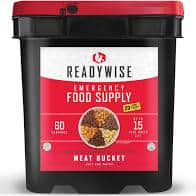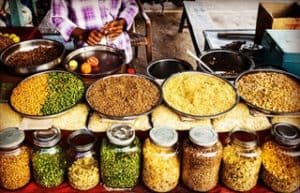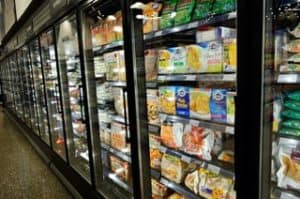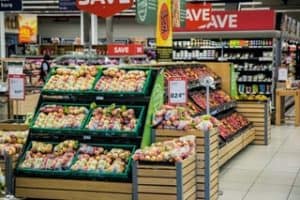
As we are being asked to maintain social distancing, shelter at home, and perhaps even face quarantine, making meals from our pantries and freezers may become part of your daily routine.
It’s no secret that dancers tend to be perfectionistic, and that often applies to their diet and eating habits. Many dancers are concerned about gaining weight as a result of changes to their usual schedule and wonder if they should cut back on how much they eat. That depends on the dancer. Instead of focusing on quantity, I encourage you to focus on the quality of your meals. Your body still needs adequate nourishment to support immunity, muscle tissue, and activities of daily living. If you cut your calories too drastically to off-set your time away from the studio, you may inadvertently decrease your basal metabolic rate, which is what is commonly called your “metabolism.” The body is much quicker to rachet down metabolism than it is to ramp it up, so keep this in mind. Shift your focus from “perfect eating” (there’s no such thing anyway) to perfectly acceptable. Just do the best with what you have.
 I like to think of this as an opportunity. It’s an opportunity to practice cooking at home. You don’t have to hone your knife skills or prepare Pinterest-perfect meals, just get into the habit of actually making your own food. Eating homemade meals is almost always healthier than prepared meals or eating out. It’s more cost-effective, which is a big consideration for many people right now. It also can be a creative outlet. Even if your supplies are limited, you can try new combinations with what you have on-hand.
I like to think of this as an opportunity. It’s an opportunity to practice cooking at home. You don’t have to hone your knife skills or prepare Pinterest-perfect meals, just get into the habit of actually making your own food. Eating homemade meals is almost always healthier than prepared meals or eating out. It’s more cost-effective, which is a big consideration for many people right now. It also can be a creative outlet. Even if your supplies are limited, you can try new combinations with what you have on-hand.
Pantry items include foods in cans and jars, dried and dehydrated foods, as well as some root vegetables like winter squash and potatoes. Pasta, grains, flours, nuts, and seeds are shelf-stable and versatile. Depending on your budget and storage space, you may need to choose between different options during different shopping outings. For example, one week you buy rice, another week you buy pasta. Basics to buy include any of the following:
Grains
- Pasta and noodles
- Rice
- Quinoa
- Oats (can be used whole or ground into flour)
- Flour
- Popcorn kernels
Proteins
- Canned tuna, salmon, or sardines
- Nuts and nut butters
- Seeds (sunflower, pumpkin, chia, hemp) and seed butters
- Canned or dry beans
- Canned or dry lentils
- Eggs (last 3-5 weeks when properly stored)
Root vegetables
- Potatoes
- Sweet potatoes
- Winter squash (acorn, butternut, delicata)
- Carrots
- Turnips
- Beets
Canned Produce
- Beans
- Green beans
- Corn
- Beets
- Tomatoes
- Olives
- Peaches
- Pears
- Mandarin Oranges
- Pineapple
 Freezer foods are pretty obvious: it’s what you have in the freezer. Fruits and vegetables are great options to buy frozen. They hold their nutrition better than some fresh options because they are flash frozen right after harvest. If you have fresh produce that you won’t be able to use before it goes bad, chances are, it can be frozen. I freeze dark greens to use in smoothies later. You may have meat in the freezer. If so, it’s a great source of nutrition. Even if it’s hot dogs, you can work small amounts of meat into your meals for added flavor, protein, fat, and micronutrients. Freezer foods I keep on hand include:
Freezer foods are pretty obvious: it’s what you have in the freezer. Fruits and vegetables are great options to buy frozen. They hold their nutrition better than some fresh options because they are flash frozen right after harvest. If you have fresh produce that you won’t be able to use before it goes bad, chances are, it can be frozen. I freeze dark greens to use in smoothies later. You may have meat in the freezer. If so, it’s a great source of nutrition. Even if it’s hot dogs, you can work small amounts of meat into your meals for added flavor, protein, fat, and micronutrients. Freezer foods I keep on hand include:
Frozen Veggies
- Broccoli
- Peas
- Corn
- Mixed veggie blends
- Stir fry mix
Frozen Fruit
- Berries
- Tropical fruits like pineapple and mango
- 100% Purple Grape Juice
Frozen Protein
- Ground beef, bison, and turkey
- Whole chicken
- Fish or shellfish, especially wild-caught, cold water fish like salmon, mackerel, or halibut
 Our food supply chain is strong, so you should be able to restock supplies over the long-haul. Stores may stock shelves or limit quantities of certain items for purchase, but there’s still plenty of food. Stock up on some basics and then include a few fresh items to balance out your plan. Fresh items include apples, oranges, root vegetables like squash and potatoes, seasonal fruits and veggies, inexpensive herbs like parsley, eggs, bread, and milk.
Our food supply chain is strong, so you should be able to restock supplies over the long-haul. Stores may stock shelves or limit quantities of certain items for purchase, but there’s still plenty of food. Stock up on some basics and then include a few fresh items to balance out your plan. Fresh items include apples, oranges, root vegetables like squash and potatoes, seasonal fruits and veggies, inexpensive herbs like parsley, eggs, bread, and milk.
Fresh Produce With Long Shelf Life
- Apples
- Oranges
- Lemons or limes
- Onions
- Garlic
- Dark leafy greens
- Herbs
When herbs or greens look like they’ll soon pass their prime, consider freezing them or adding them to soups or casseroles. If you see overripe bananas on sale, pick them up and eat them with away, or freeze to use later in baked goods or smoothies.
Here are a few tips to consider for making meals that are affordable, tasty, and nutritious:
- Buy foods that can be used in multiple meals like rice, pasta, and eggs.
- Start building a pantry of spices that you can use to flavor your foods. Spices can be expensive, so choose basics like cinnamon and cumin to start. If possible, pick up a couple herb plants and grow your own herbs rather than buying fresh versions.
- Think weekly and mix things up each week or every couple weeks, depending on your situation. Perhaps one week, use rice as a staple and build meals around it. The next week, opt for a different grain like quinoa, kasha, or oats.
- Buy seasonal produce for maximum quality and flavor, as well as lowest prices.
- Add fresh or frozen veggies when you can for more flavor, interest, and nutrition. Canned veggies are a great option to keep on hand. You might find that you prefer frozen peas to canned peas. Broccoli typically comes frozen, but beets are a great choice in a can.
- Eggs have a shelf like of 3-5 weeks and are a great source of mood-supporting nutrients including choline, vitamin D, and omega-3 fatty acids. They are super versatile and a great food bargain, even if you buy the more expensive, pastured version.
- Keep onions and garlic on hand. Not only do they offer tons of flavor to foods, they offer health-supporting compounds at an exceptional price point.
When working with what you have on-hand, use a simple formula of 1 part protein (plant or animal source), 1 part carb/starch, some healthy fat, 1 or more parts veggies, and extra flavor from alliums like garlic and onion, herbs, spices, vinegar, lemon juice, or dried fruit. I’ve created an infographic to give you some ideas. CLICK HERE FOR INFOGRAPHIC
For inspiration, consider international cuisines. Mexican and Italian traditions are easy to implement at home with rice, beans, pasta, and canned tomatoes. Don’t feel like you need to need to create new and exotic dishes every day. Find what works for you and then build from there. Starting with a workable repertoire of one or two dishes is doable. I’ve created a collection of shelf-stable recipes for dancers that you can grab here.
If you’re interested in learning more, follow me on Instagram @kristin_koskinen_rdn and visit my website, www.eatwellpros.com
Kristin Koskinen, RDN
Kristin Koskinen, RDN, LD,CD is a registered dietitian who grew up dancing. Her interest in nutrition began when she was in her teens and danced in a pre-professional ballet company. There was a lot of talk among the dancers about diets and weight loss, but not much understanding about nutrition to maximize performance or the disordered eating that too often results from dieting. Now, she is a resource for dancers and those who support them.
Kristin owns a private practice where she offers nutrition counseling with a focus on performance nutrition. She incorporates the functional aspects of food in her approach to help artistic athletes of all levels. Her integrative approach recognizes that nutrition isn’t just about the food you eat. It’s important to take many factors into consideration, including environment, cultural influences, social norms, and body image, especially when working with dancers.
She is an active member of the International Association for Dance Medicine & Science, Academy of Nutrition and Dietetics, Doctors for Dancers, and a founding member of DanseMed. She is regularly invited to speak on topics related to dancer health and is a frequent contributor to media including Dance Magazine, Shape, Oprah, Healthline, NBC, and Today.com. You can find her on social media or at her website, www.eatwellpros.com.
Social Media
IG: Kristin_Koskinen_RDN
FB: Eat Well, Live Well (@eatwellpros)
Twitter: Eat Well, Live Well (@eatwellpros)
LinkedIn: Kristin Koskinen, RDN, LD, CD
Email: kristin@eatwellpros.com
